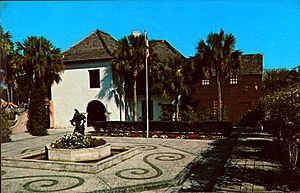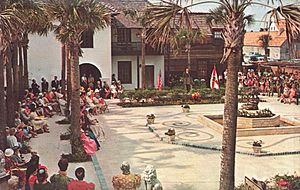Hispanic Garden facts for kids
Quick facts for kids Hispanic Garden |
|
|---|---|
 |
|
| Location | St. Augustine, Florida |
| Owned by | St. Augustine Foundation, Inc. |
The Hispanic Garden is a special garden located in St. Augustine, Florida. It was created to celebrate the strong historical ties between Spain, Latin America, and Florida.
Contents
How the Garden Began
The idea for the Hispanic Garden started with a group called the St. Augustine Historical Restoration and Preservation Commission. They wanted to create a place that showed the shared history of these regions.
They bought land between two important buildings: the Casa del Hidalgo (a former Spanish tourism office) and the Pan American Center. This spot was perfect for a symbolic garden.
Raising Money for the Garden
A committee, led by Elizabeth Towers, worked hard to raise money for the garden. They needed $45,000! They held many fun events like fashion shows and art auctions. They also sold small items, including coins and paper bulls from the 1964 New York World's Fair.
A very generous person named Jessie Ball duPont donated over $30,000 to the project. Her help made the garden possible.
Designing a Spanish-Style Garden
Two talented women, Lee Schmoll and Drusilla Gjoerloff, designed the garden. They were the only female landscape architects working in Florida at that time.
Their design was inspired by beautiful Spanish gardens called "plazoletas," like those found at the famous Alhambra Palace in Spain. The garden was shaped like a trapezoid, about 76 by 82 feet. An arbor (a shaded walkway) was added to make it look more square. This arbor was covered with sweet-smelling Confederate jasmine and Cherokee roses, offering a cool place to rest.
The designers chose not to have grass in the garden. This was to make it look more like gardens from the past. The plants chosen were either native to Florida or were brought by Spanish settlers in the 1500s. These included cabbage palms, kumquats, marigolds, and yaupon holly.
Queen Isabella's Statue
In the center of the garden, there is a bronze statue of Queen Isabella riding a donkey. This beautiful sculpture was created and donated by artist Anna Hyatt Huntington.
Underneath the statue, there is a square pool. Around the pool, you can see a colorful mosaic made of small pebbles. This mosaic also has a classic Spanish design.
Dedication and Celebrations
The Hispanic Garden Committee hoped to finish the garden by September 8, 1965. This date was special because it was St. Augustine's 400th anniversary!
Even though it wasn't fully completed, the garden was officially dedicated on September 5, 1965, as part of the big celebrations. The project was finally finished two years later. It was rededicated on May 2, 1967. At this time, its name was changed from Hispanic Garden to Hispanic Plaza, as people felt "plaza" better described its purpose.
Archbishop Joseph Hurley and St. Augustine Mayor John D. Bailey attended this second dedication. The Archbishop gave a special blessing to the garden.
The Garden Today
Between 2000 and 2003, the Queen Isabella statue was temporarily moved. This was so archaeologists could dig in the garden. They found many old items from American Indian, British, Spanish, and American history!
After 2003, a new fence was put up around the garden to protect it from damage. The city didn't have enough money for all the repairs, but David Drysdale, who owns the St. Augustine Alligator Farm Zoological Park, generously donated the needed funds. His mother was even part of the original committee that helped create the garden!
Today, the St. Augustine Foundation, Inc. owns and takes care of the Hispanic Garden. It's usually closed to the public, but it opens for special city events. These include the St. Augustine Easter Week Festival and special knighting ceremonies.



